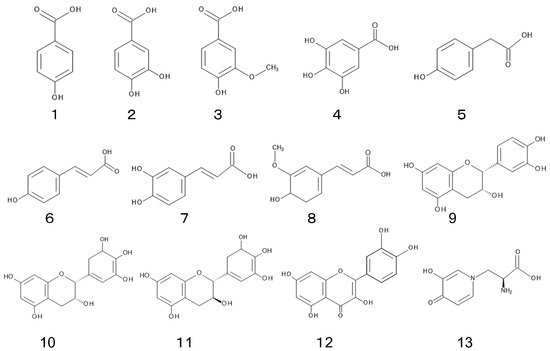Leucaena leucocephala (Lam.) de Wit is native to southern Mexico and Central America and is now naturalized in more than 130 countries. The spread of L. leucocephala is probably due to its multipurpose use such as fodder, timber, paper pulp, shade trees, and soil amendment. However, the species is listed in the world’s 100 worst invasive alien species, and an aggressive colonizer. It forms dense monospecific stands and threatens native plant communities, especially in oceanic islands. Phytotoxic chemical interactions such as allelopathy have been reported to play an important role in the invasion of several invasive plant species.
- invasive plant
- allelochemical
- mimosine
- phytotoxicity
- rhizosphere soil
1. Introduction

2. Allelopathy
Allelopathy is chemical interaction among plants and caused by allelochemicals [27][30], which are produced in plants and released into the vicinity of the plants including rhizosphere soil either by root exudation, decomposition of plant litter and residues, and rainfall leachates and volatilization from the plant parts [28][29][30][50,51,52].2.1. Plant Extract
Allelopathic activity of the extracts of leaves, seeds, bark, and aerial parts of L. leucocephala on crops and weeds were determined since allelochemicals are synthesized and accumulated in certain plant parts [27][28][29][30][30,50,51,52]. Aqueous extracts of the leaves of L. leucocephala suppressed the radicle growth of Lactuca sativa L. and Oryza sativa L. seedlings [31][28], and the seedling growth of Ischaemum rugosum Saisb and Vigna radiata (L.) R. Wilczek [32][53]. Its aqueous leaf and seed extracts showed the inhibitory activity on the germination and seedling growth of three weed species, Ageratum conyzoides L. Tridax procumbens L., and Emilia sonchifolia (L.) DC. Ex Wight [33][54]. Aqueous leaf, seed, and bark extracts of L. leucocephala inhibited the germination, growth, and crop yield of Zea mays L. under pot culture conditions [34][55].2.2. Leachate
For the simulation of rainfall conditions, plant tissues were soaked in water, and its supernatant was used as leaches from the tissues by rainfall [35][36][37][38][39][60,61,62,63,64]. The senescent leaves of L. leucocephala was soaked in water for 48 h, and its supernatant showed inhibitory activity on the germination and growth of Raphanus sativus L. [37][62]. The soaking water of L. leucocephala leaves also enhanced electrolyte leakage from the leaf cells of Eichhornia crassipes (Martius) Solms. and increased the activities of catalase and ascorbate peroxidase in the leaves [38][63].2.3. Plant Litter and Residue
Leaf litter of L. leucocephala was mixed with soil, and the seeds of a woody plant, Albiza procera (Roxb.) Benth., and crop plants, Vigna unguiculata (L.) Walp., Cicer arietinum L. and Cajanus cajan (L.) Millsp. were sown into the mixture. The treatments resulted in the suppression of the germination and growth of these test plant species [39][64]. Soil mixture with decomposing leaves of L. leucocephala increased the mortality of five tree species, Alnus formosana (Burkill) Makino, Acacia confusa Marr., Liquidambar formosana Hance, Casuarina glauca Sieber, and Mimosa pudica L. [31][28]. Aqueous extracts of L. leucocephala litter, which accumulated on the forest floors, showed the suppression of the germination and radicle growth of Lolium multiflorum Lam. [31][28], and Ageratum conyzoides L. Tridax procumbens L., and Emilia sonchifolia (L.) DC. ex Wight [40][65]. Leaf mulch of L. leucocephala covered on soil surface or mixed with soil inhibited the germination and growth of Vigna unguiculata (L.) Walp., and the root nodulation of V. unguiculate [41][66]. Those observations indicate that leaf litter and residues of L. leucocephala may contain certain allelochemicals, and some of them may be liberated into the soil during their decomposition processes.2.4. Rhizosphere Soil and Root Exudate
The seeds of Ageratum conyzoides L., Tridax procumbens L., and Emilia sonchifolia (L.) DC. ex Wight were sown into the soil collected from L. leucocephala infested areas. The treatments resulted in the suppression of the germination and growth of those plant species [40][65]. Rhizosphere soil of L. leucocephala also inhibited the germination and growth of Vigna radiata (L.) R.Wilczek and Glycine max L. [42][67]. Aqueous extracts of the soil of the forest floors under L. leucocephala trees showed the inhibition of the radicle growth of Lactuca sativa L. [31][28]. In addition, root exudates from L. leucocephala showed the suppression of the germination and growth of Ageratum conyzoides L., Tridax procumbens L., and Emilia sonchifolia (L.) DC. ex Wight [40][65]. Those observations suggest that rhizosphere soil of L. leucocephala may contain certain allelochemicals, which may be supplied through root exudation, decomposition of plant litter and residues, and rainfall leachates.34. Allelochemical
Phenolic acids, flavonoids, and mimosine were isolated and identified from L. leucocephala as its allelopathic agents (Figure 23).
3.1. Phenolic Acid
4.1. Phenolic Acid
Phenolic acids such as p-hydroxybenzoic acid (1), protocatechuic acid (2), vanillic acid (3), gallic acid (4), p-hydroxyphenylacetic acid (5), p-hydroxycinnamic acid (6), caffeic acid (7), and ferulic acid (8) were identified in the leaves of L. leucocephala. Total concentrations of those phenolic acids in young leaves were 2-fold greater than those in mature leaves [31][28]. The concentration of total phenolic compounds in L. leucocephala plants was estimated to be 1.3 to 2.8 mg g−1 of dry weight of the plants [43][68]. Phenolic acids have been found in a wide range of plants, plant residues, and soils, and their involvement has been often mentioned in the allelopathy of those plant species [44][45][69,70].
